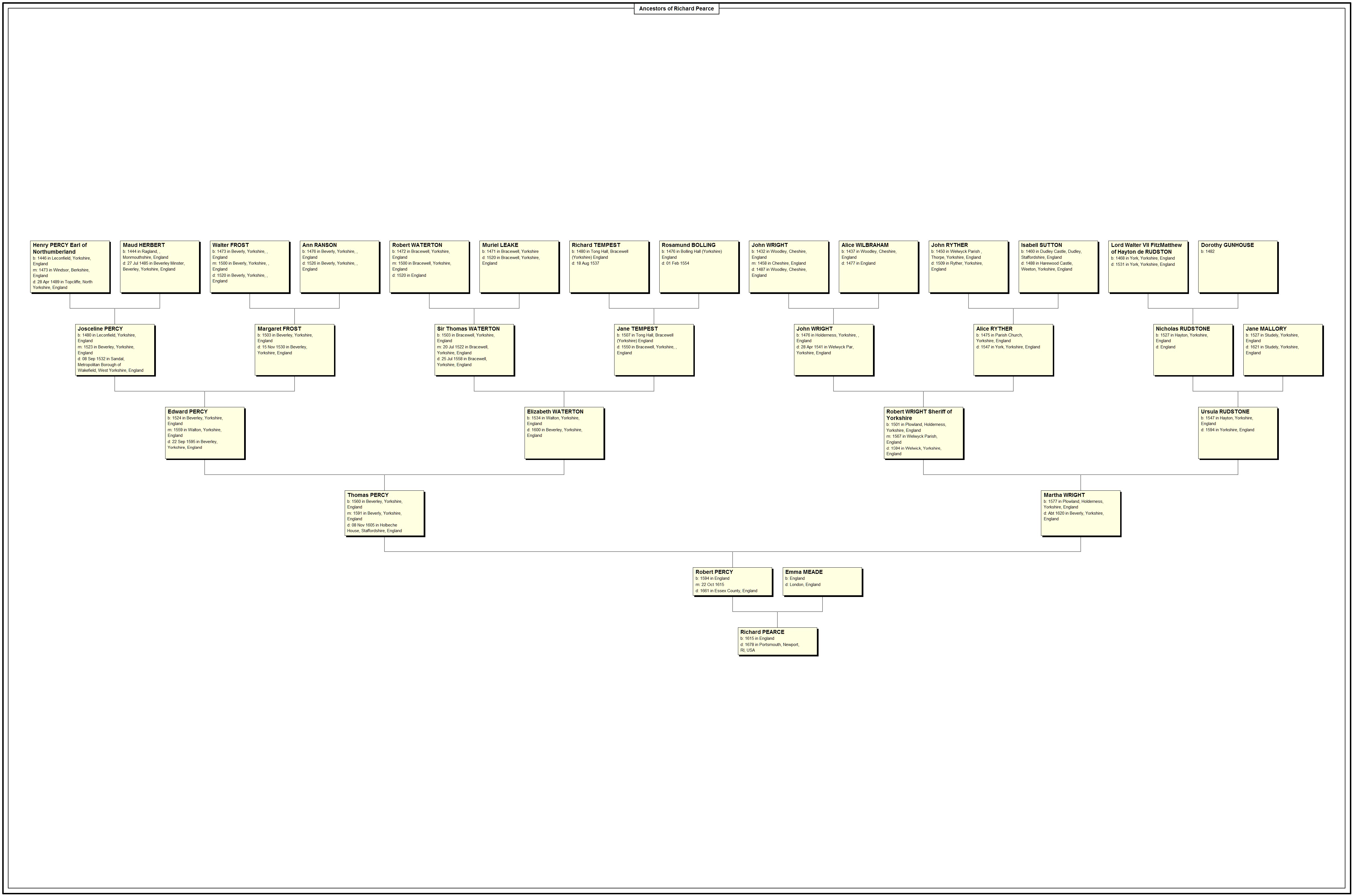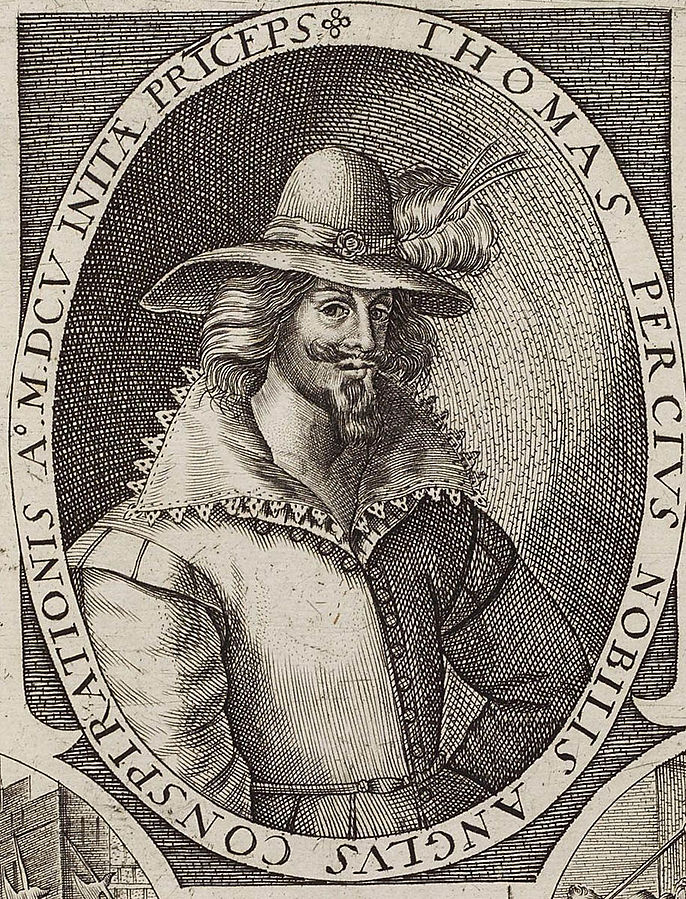
by Laura Knight
~~~
These are technical research notes on Pearce Genealogy and will probably only make sense to experienced genealogists. For those who are just getting their feet wet, or who have been taken in by that fraudulent book "Pearce Genealogy" by Frederick Chilton Pearce, I'll give you what appears to be the correct lineage at the end.
See first: Genealogy of the House of Percy Table 1, Table II, Table III
For a number of reasons, detailed below, I believe that Richard Pearce of England who married Susannah Wright there, at Waltham Abbey, who then came to America and settled in Rhode Island, was descended from Thomas Percy of Gunpowder Plot Fame.

Below, I will present the main ideas and connectors, but it is an abridged version of my sustained argument which includes more detailed records and commentary and runs about 100 pages.What is fascinating is to see the overlap of actors in this historical drama with those of the Capt. Peter Knight drama which also involved Ingle's Rebellion.
Richard Pearce was:
Born 1615 – England
Died 22 April 1677, Portsmouth Rhode Island
Married Susannah Wright.
“In the "Pearce Genealogy," by Col. Frederick C. Pierce, which was published in 1888 and relates chiefly to Richard Pearce of Portsmouth R.I, and his descendants, it is stated that Richard Pearce's father was of Bristol, England, and that Richard himself was born in England in 1615, was at Portsmouth, R. I. as early as 1654, and married in Portsmouth, in 1642, Susannah Wright, who was born in 1620. Susannah Wright is said to have been the daughter of George Wright of Newport, R. L, who was probably at Salem, Mass., 1637, and at Newport in 1648. (Pearce Genealogy, pp. 37, 38.).
“Without considering here the question whether the English home and the date of birth of Richard Pearce are given correctly in the "Pearce Genealogy," there is no doubt that the maiden name of Richard Pearce's wife was Susanna Wright; but she was the daughter not of George Wright of Newport but of John Wright of Waltham Abbey, co. Essex, England, yeoman, as the entry in the "Aspinwall Notarial Records" proves.”
The entry in the Aspinwall Notarial Records, published Boston, 1903, pp. 85-86:
"Richard Pierce of Prudence Island in the Narrowgansett Bay did acknowledge the receite of twenty pounds of Elizabeth Dell Executrix of the last will & Testament of Raph Dell of Bow in Middlesex due as a Legacie unto his wife Susanna daughter of John Wrighte of Walton [Waltham] Abbey parish in Essex yeoman: & doth acquitt & discharge the said Elisabeth of the said Legacie & every part thereof. Signed & sealed the 14 (7) before me the Not. publ. 1647."
Thus, it appears certain that Richard Peirce/Pierce/Pearce and his wife Susannah, related to the Dells of Middlesex, were in America as early as 1647. (Benjamin Franklin Wilbour, "Parentage of Susanna Wright, wife of Richard Pearce of Portsmouth, R. I.," New Eng. Hist. Gen. Reg., 84 (1930): 427-433)
There are numerous land records for Richard Pearce beginning in 1654, and perhaps earlier, though that is the earliest I have.
He left a will, named children, etc. All pretty much standard. So much for Richard Pearce in America.
Turning to the problem of his origins. The book "Pearce Genealogy," by Col. Frederick C. Pierce, mentioned above, which was published in 1888, has a whole fanciful genealogy that is repeated ad nauseum by endless Pearce/Pierce/Peirce descendants. (My own line comes from one who chose and stuck with the Pearce spelling). Col. Pierce’s fancy takes Richard’s family from Bristol back to “Pearce Hall” in Yorkshire through a string of obvious “placeholder” ancestors to Peter Percy son of Ralph Percy, son of the Earl of Northumberland, Bosworth Field and all that.
The problem is: none of it has a shred of evidence and the dates don’t even fit nor has there ever been, as far as I can tell, a “Pearce Hall” in Yorkshire. It’s a load of horse-hockey.
However, with Mr. Wilbour’s information linking Susannah Wright, wife of Richard Pearce, to Ralph and Elizabeth Dell of Bow in Middlesex, we find:
FROM PROBATE RECORDS
(Ralph Dell born 1575):
The Will of RALPH DELL of Bow in Middlesex, citizen and cloth worker [date not given in abstract].
Proved in 1646. (P.C.C., Twisse, 184.) (71 yrs old)
*Cf. the will of George Dell of Boston mariner, dated 3 Nov. 1653 (Register, Vol 5 p 442), in which the testator names his brother Mr. Richard Barachew, Living at Hackney near London and his brother Ralph Dell. Perhaps Richard Barolers of Harksey may be identical with Richard Barachew of Hackney, the names in one will or the other having been difficult to decipher. (This George Dell appears to be the nephew of Ralph Dell, brother to Ralph, sons of John Dell.)
Ralph Dell stated "I haueing no child" and the bequest to the Children of John Wright was later in the will than those to his brothers and sisters. However, I looked at "London Marriage Licences", edited by Joseph Foster, London, 1887 which you can access free on Google Books, and found the following:
"John Wright, of Waltham Abbey, co. Essex, yeoman, and Mary Dell, spinster, daughter of John Dell, of same, yeoman - at St. Mary Axe, London, 17 Apr 1624. Bishop of London's Office."
Also, "John Wright, of Waltham Abbey, co. Essex, yeoman, and Mary Dell - at Waltham Abbey, aforesaid, 19 Apr 1624. Bishop of London's Office."
The Will of ELIZABETH Bright DELL of Stratford-le-Bow, co. Middlesex, widow [date not given in abstract].
Overseers: my brother Blowers and my brother William Forth. Executor: my nephew, Dr. William Forth. Proved at Doctors’ Commons. London, 6 August 1657. (P.C.C.) **
Note that she makes no bequests to children or grandchildren, to no one named Dell or Wright so she is not the mother of Mary Dell,
So it seems that Mary Dell, sister of Ralph Dell, was initially listed as an inheritor but died between the time the will was first made and the time the Wright children were added. Thus, Mary Dell appears to be the sister of Ralph Dell.
I found the marriage record of Ralph Dell and Elizabeth Bright Dell. Marriage was on 6 Jul 1631 at St. Mary's church, Stratford Bow. I took a digital photo of the entry in the book. She was born in 1598 and was thus 33 years old when she married the 56 yr old Ralph Dell (b. 1575). This goes well with him having written that he had no children as well as the confirmation that Mary Dell who married John Wright was the daughter of John Dell and was Ralph’s sister.
The following is from the Parish Registry of said Waltham Abbey:
FROM THE PARISH REGISTERS OF WALTHAM ABBEY.
1563-1650*DELL
Baptisms
1607 Ralph son of John Dell 13 September.
1611 Ralph son of John Dell 21 April.
1621 George son of John Dell 4 November.
1627 Elisabeth daughter of John Dell 20 January [1627/8].
1632 Margaret daughter of John Dell ____ August.Marriages
1624 John Write and Mary Dell 22 April.
1625 John Dell and Bridgett Warer[?] 28 July.Burials
1607 Ralph son of John Dell. 1 November.
1629 A nurse child of Bridgett Dell 21 November.
1634 Margaret daughter of John Dell - February [1634/5].PIERCE
Births
1655 John son of Robert Pierce 22 January [1655/6].
1659 Charity daughter of Robert Pierce 6 April.Marriages
1642 Richard Pierce and Susan Write 5 May.
1655 George Wilson and Martha Pierce 22 January [1655/6]Burials
1661 Robert Pierce, innkeeper, 22 October.
1661 Charles Morgan died at Richard Pierces and was buried 19 November.WRIGHT
Baptisms
1563 Thomas son of Richard Wright 26 _____.
1564 Lawrence son of George Wright 7 May.
1565 Thomas son of Robert Wright 3 June.
1567 Jane daughter of George Wright 12 January [1567/8].
1567 Henry son of John Wright 5 March [1567/8].
1569 Robert son of George Wright 14 August.
1569 Thomas son of John Wright 30 August.
1570 Margaret daughter of John Wright 30 July.
1570 Robert son of Robert Wright 5 March [1570/1].
1572 Bridgett daughter of George Wright 2 April.
1573 Henry son of Henry Wright 30 August.
1574 John son of John Wright 24 January [1574/5].
1576 Robert son of John Wright 26 August.
1582 Magdalen daughter of John Wright 8 July.
1599 Elisabeth daughter of Thomas Wright _____ February [1599/1600]
1600 Robert son of Robert Wright 25 May.
1601 Philip son of Robert Wright 27 June. q
1601 Sarah daughter of Henry Wright 17 January [16012]
1603 Margaret daughter of Philip Wright 18 June.
1603 Mary daughter of Thomas Wright 17 August.
1603 Robert son of Robert Wright 28 August.
1605 William son of Robert Wright 12 July. 1
1605 William son of Thomas Wright - November.
1605 Catharine daughter of Philip Wright 2 February [1605/6].
1606 Frances daughter of Robert Wright 1 June.
1608 Frances daughter of Robert Wright 29 May.
1608 Sarah daughter of Hary Wright 30 July.
1610 Ann daughter of Philip Wright 29 July.
1624 John son of John Write** 20 February [1624/5].
1627 Susanna daughter of John Write 5 August.
1629 William son of William Wright 28 June.
1630 Henry son of Christopher Wright 20 May.
1631 William son of Robert Wright 22 January [1631/2].
1633 Ann daughter of John Write 29 August.
1635 Ralph son of John Write 26 September.
1637 Henry son of John Write 16 May.
1646 John son of William Wright - August.Marriages
1568 Wright and Ellen Lightsent 27 June.
1569 John Wright and Margaret 26 May.
1569 John Wright and Agnes Pecock 15 August.
1574 Clement Basley of Sapwood and Agnes Wright 2 May.
1598 Henry Wright and Sarah Marble 6 November.
1599 Robert Wright and Alice Green 17 June.
1602 Robert Wright and Susan Cawell 18 July.
1602 Philip Wright and Mary Meghill 4 November.
1607 William Bellamy and Jane Wright 29 January [1607/8].
1617 Richard Stock and Katherine Wright 16 June.
1620 Anthony Benton and Jane Wright 5 November.
1624 John Write and Mary Dell 22 April.
1628 George Burton and Frances Wright 14 April.
1630 Henry Wright and Elisabeth Barker 14 July.
1636 Bazzell Bull and Jane Wright 1 September.
1642 Richard Pierce and Susan Write 5 May..
1642 Patrick Wright and Elisabeth Stock 20 October.Burials
1568 Alley wife of John Wright 15 July.
1570 John Wryght, tanner, 20 December.
1573 George Wryght of leberts hell*** 20 January [1573/4].
1573 Jane [Wright], late widow, 28 February [1573/4].
1574 Henry son of Henry Wright 5 March [1574/5].
1577 William Wright 29 September.
1586 Alice Wright - March [? 1586/7].
1597 Catherine Wright 21 January [1597/8].
1600 Robert son of Robert Wright 30 May.
1603 Ellen wife of John Wright 11 September.
1603 John Wright 1 October.
1637 Susan wife of Robert Wright - January [1603/4].
1606 Robert son of Susan[?] Wright 9 October.
1610 Margaret daughter of Philip Wright 2 January [1610/11].
1611 Thomas Write of Surestone 26 March.
1626 John son of John Wright 30 September.
1626 Ann Wright 3 November.
1629 Sarah wife of Henry Wright 19 February [1629/30].
1631 Robert Wright, butcher, 26 November.
1632 Nicholas Wright, a poor man, - May.
1632 Alice Wright, a widow, 15 August.
1632 Elyn daughter of John Write 5 November.
1634 Henry son of Christopher Wright 8 December.
1637 Mary wife of John Write of Surestone 23 February
1638 Amy daughter of John Write 4 June.
1640 Widow Write of Surestone 4 November. 1
1640 Henry Wright 29 November.
1643 John Write 5 July.
1645 Ann wife of William Wright 4 August.
1645 Robert son of Christopher Wright 23 August.
1648 Margery wife of William Wright 13 April.*The parish registers of Waltham Holy Cross (Waltham Abbey), CO. Essex, begin 1 June 1563. A description of them, with some of the more interesting entries and much antiquarian lore relating to this parish, may be found in Our Parish Registers, by W. Wintera. Waltham Abbey, 1885.
** The Wrights of Surestone (Sewardstone), a village near Waltham Abbey,
were recorded in the Parish registers under the spelling Write.*** That is, Lippets Hill.
What caught my eye was the dearth of Pierces in the Parish records of Waltham Abbey. It's as though the first "attractor" of the family to that location rested in the marriage of Richard Pierce/Pearce to Susanna Write/Wright. Richard Pearce came from elsewhere, probably semi-local.
My eye was caught by the two burials mentioning same:
1661 Robert Pierce, innkeeper, 22 October.
1661 Charles Morgan died at Richard Pierces and was buried 19 November.
I wondered: was this Robert Pierce the father of Richard Pierce? So, I went looking for Robert Pierce/Pearce/Percy. And that's when things began to get weird. I came across the following extract:
From: “Abstract drawn up by Sir Wm. Dugdale, proving Mr. Francis Percy, now of Cambridge, to be of the line and family of the Percys, Earls of Northumberland” (From The House of Percy, p.359)
Sept. 6, 1680. — Roger England of Taunton in Somersetshire, aged 80 years, certifieth that he married Anne daughter of Robert, son of Thomas the Powder Traytor, and has heard the said Robert, his wife's father, say that he was son to Thomas Percy, who was employed in the Powder Plot. "
Oct. n, 1680. — John Swinton, clerk of ye parish Church of Anwick in Northumberland, aged above 80 years, affirmeth that he heard his father say that Mr Thomas Percy and his wife lived in the Castle at Anwick and had children, and after the Powder Plot for which ye said Thomas lost his life, his wife went to London and lived privately there. "
It’s also said that MARTHA WRIGHT (notice name Wright!) moved to Holborn, London with her children, CHANGED HER NAME, and opened a school or something.
Oct. 14, 1680.— Matthew Scott of Gateshead in the Bishoprick of Durham, aged 99 years, certifieth that he knew Thomas Percy, who was afterwards in the Powder Plot, Constable of Anwick Castle, and that he had a son called Robert and two daughters, and that the said Robert was a schoolboy at Anwick. "
February 12, 1680: Richard (sic) Percy, widow of Francis Percy, son of Robert, aforesaid, aged 76 years, sayeth that she knew the said Robert Percy, her late husband’s father, and has often heard him say he was the son of Thomas Percy who was in the Gunpowder Plot: and that above 16 years since, ye said Francis, her late husband, purposing himself to make himself known as Algernon, Earl of Northumberland, went from Bickley in Devonshire, where he then lived, towards London for that end, but on his way falling sick at Oxford, returned home, where he shortly died.”
{Collectanea Topographica Et Genealogica, Volume 2 edited by Frederic Madden, Bulkeley Bandinel, John Gough Nichols verifies that 1641 marriage record to "Rich hord" Parsons. In 1680, she was called Richard, widow of Francis, son of Robert Percy. She was 76 in 1680.
Bickley, Devon baptismal and marriage records:
Francis Pearsie (groom)
marries 9 July 1640 to Richoard Parsons (sic) at Bickley, near Exeter, Devon.Elizabeth Persie bpt. 1 Jun 1641, daughter of Francis Persie, at Bickley, near Exeter, Devon.
Dorothie Persie bpt. 1 Nov 1643, daughter of Francis Persie, at Bickley, near Exeter, Devon.
Francis Percy bpt. 19 May 1649 son of Francis Percy, at Bickleigh, near Exeter, Devon
Peter Perci bpt. 7 Aug 1654 son of Francis Perci, at Bickley, near Devon, England. }
So, we have a Robert Percy born at Alnwick about 1594, child of Thomas and Martha Wright. I ended up having to read the entire account of the Trunkmaker and all that from “The House of Percy” by Brenan, along with all the other background I could find. The following is of interest:
From the History of the House of Percy, about the claimant, James Percy:
Percy's researches in the registers of Pavenham Bury, Harrowden, and Horton had proved his clear and legitimate descent for three generations. He was himself born at Harrowden in 1619, the second but cldest Surviving son of Henry Percy (sometime Servant to Lord Bacon) and Lydia Cope, daughter of Dame Cope of Horton, Northants.' His father, Henry, was the third son of another Henry Percy, by his wife, the daughter of James Tibbot of Pavenham Bury, co. Bedford. The eldest son of this last-mentioned Henry was the James Percy, uncle of the Claimant, who died in Ireland without male issue in 1654.* The second son, William, had already died in childhood ; so that the representation of the family devolved upon the "Trunkmaker."Beyond his paternal grandfather Percy could not trace by the evidence of any documents at his disposal. He had, however, inherited a family tradition that this first Henry, together with three other children, brothers and sisters, were of near kin to the Earls of Northumberland, and that they had been brought from the North by stealth immediately after the re-establishment of Protestantism in 1559. Of one of these brothers, his grand-uncle Robert Percy, the Claimant had personal knowledge; and he claimed to be able to produce numerous witnesses from the districts about Pavenham, Harrowden, and Horton, who would swear to the coming of the four from the North, and their settlement in that part of the country.
The story may seem too romantic to be true, but the period was one which produced many stranger romances; and there is not wanting a very similar case which occurred almost at the same time, and which rests upon a historical basis. Several children of the ancient Catholic family of Tempest of Holmside in Durham were smuggled out of their own home by friends during the Elizabethan persecutions, and sent to fosterage with respectable families in Oxford and Kent, where they grew up as peasants, or at least in stations far beneath the rank of their ancestors. (Surtees: History of Durham, Chester Ward)
Whether the Claimant's ancestors were actually brought to Northamptonshire in this manner or not, seems past positive proof or refutation ; but it is worth observing that James Percy found at least one believer in his published account of the tradition who, from her intimate knowledge of the Northumberland family ties, deserves at least to be heard with attention. This was Anne, Countess of Pembroke and Montgomery, a descendant of Henry Clifford, Earl of Cumberland, by his marriage with Lady Margaret Percy, sister of the " unlucky Earl." It will be remembered that the Earl of Cumberland was a practical sympathiser with his luckless brother-in-law during the latter's marital troubles, and indeed acted for a time as guardian of the Percy estates. Lady Pembroke openly stated at Court and elsewhere that "if the Trunkmaker really came from Pavenham, he must be one of those four Percy children that in the time of the troubles in 1559 were sent out of the North in Hampiers to old Dame Vaux at Harraden in Northhamptonshire."
(Elizabeth Cheyne, heir of Pavenham was this Lady Vaux and all her generation were Catholic. Her son William, third Lord Vaux, married (2nd wife) Mary Tresham, aunt of Francis Tresham of the Gunpowder Plot. Pavenham was held by Sir Thomas Cheyne, knt., from whom it passed to his daughter and heir Elizabeth, wife of Thomas, second Lord Vaux of Harrowden.){Lady Pembroke was the sole daughter and heir of George Clifford, Earl of Cumberland and had married, firstly, Richard Sacville, third Earl of Dorset (by whom she had issue two daughters and co-heirs, Margaret, wife of John Tufton, Earl of Thanet, and Isabel, wife of James Compton, Earl of Northampton) ; and secondly, as his second wife, Philip Herbert, fourth Earl of Pembroke and first Earl of Montgomery (by whom she had no issue). It should be recalled that Maud Herbert, mother of Josceline Percy of Newlands/Beverley, was the daughter of the Earl of Pembroke.}
" According to the "Register Booke" of Horton, Henry Percy and Lydia Cope were married by licence in 1614. Two children, Henry and Eliza, were born to them before James, but both died in early youth. The birth of William, illegitimate son of Henry Percy by Mary Varnum, may also be seen in this register.
From Brenan we get:
"By a certificate of the 17 September 1680, taken out of the Church Register of Wiveliscomb, Somerset, it appeareth that Robert Percy did marry Emma Meade 22 Oct. 1615. "
"By a certificate of ye 10 May 1680, taken out of ye Church Register of Taunton in Somerset, it appeareth that Francis ye son of Robert Percy was there baptized 15 April 1616. "
That is: he was born six months or less after his parents were married. Francis Percy is also said to have been baptized: April 15, 1616, Bickley, Devon, England. (Is it just another way to say the same place?)
In his History of the Hundred of Willey (Bedfordshire), Mr. William Marsh Harvey gives the following extracts from the Pavenham Registers :
"James Pearcye fil. Henrici Percye, baptizat. fuit xij" die februarij, A, duj, 1581."
"Baptized Willm. Pearcey,fillius Henrici Pearcy, 15 Dcccmbris, 1583."
" Baptiz. Maria Pearcye filia Henrici Percye, 27 Septemhiis, 1 590."
'' Baptiz. Alicia Pearcye filia Henrici Pearci Januarij 18, Ao. q. dui. 1593."
" Sepulti fuere duo ( Willm.) filii Henrici Pearci partus 20 die Januarij Anno dui. 1592."
The baptism of a Francis, son of " Laurance Percy," and the marriage of a "Thomas Pearcye" and Elizabeth Seamer are also quoted.
In the register of the neighbouring parish of Carlton, Bedfordshire, under date of January 30, 1596, is recorded the baptism of a "John, son of Laurence Percy."
In respect of the story of the Tempest children quoted above, notice that Elizabeth Waterton's (wife of Edward Percy, father of Thomas of GPP) mother was a Tempest.
The author and collector of the above data, Dugdale, cited in Brenan’s book writes about Robert: "It is unknown where he died." In other words, the Francis and/or his widow, haven’t a clue about the whereabouts or fate of the alleged father of Francis.
Another researcher found the following items and sent them to me:
[Regi]ster of the names of all ye Passinger which Passed from ye Port of London for one yeare Endinge at Xpmas 1635.
Posi festum Natalis Christi 1634. vsq' ad festum Na: Christi 1635 Secundo Januarij 1634
THEIS vnder written are to be transported to Virginea imbarqued in ye Merchant bonaventure JAMES RICROFTE Mr bound thither have taken ye oath of Allegeance.
Name Age
WILLM SAYER 58
ROBERT PERCY 40
EDWARD CLARK 30
Based on age, this is our Robert Percy born in 1594. We notice that Robert is NOT traveling with his wife and children.
We find him next in America. I've collected a set of record extraction images below which can be downloaded and zoomed for easier reading:
Item 1 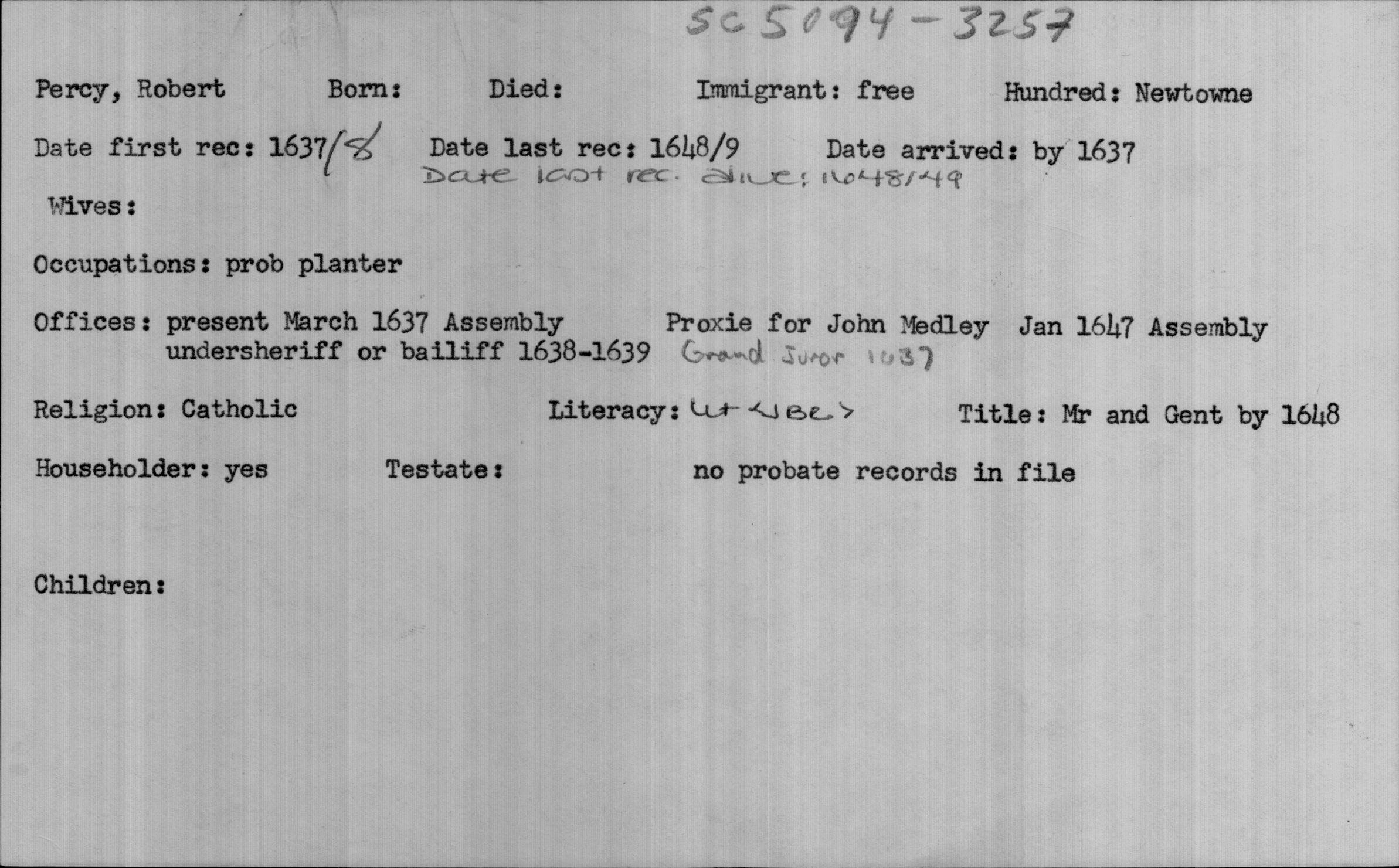 |
Item 2 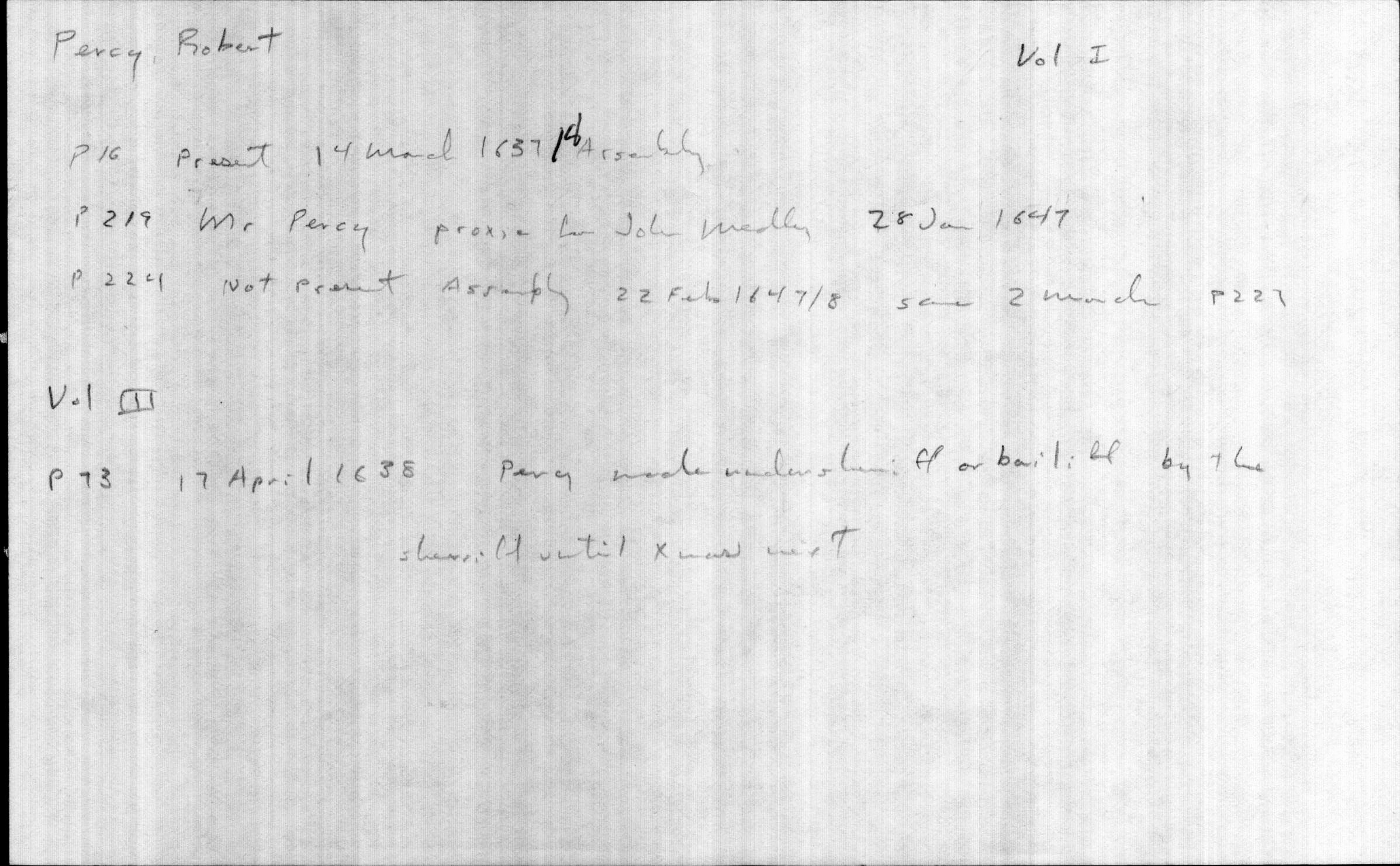 |
Item 3 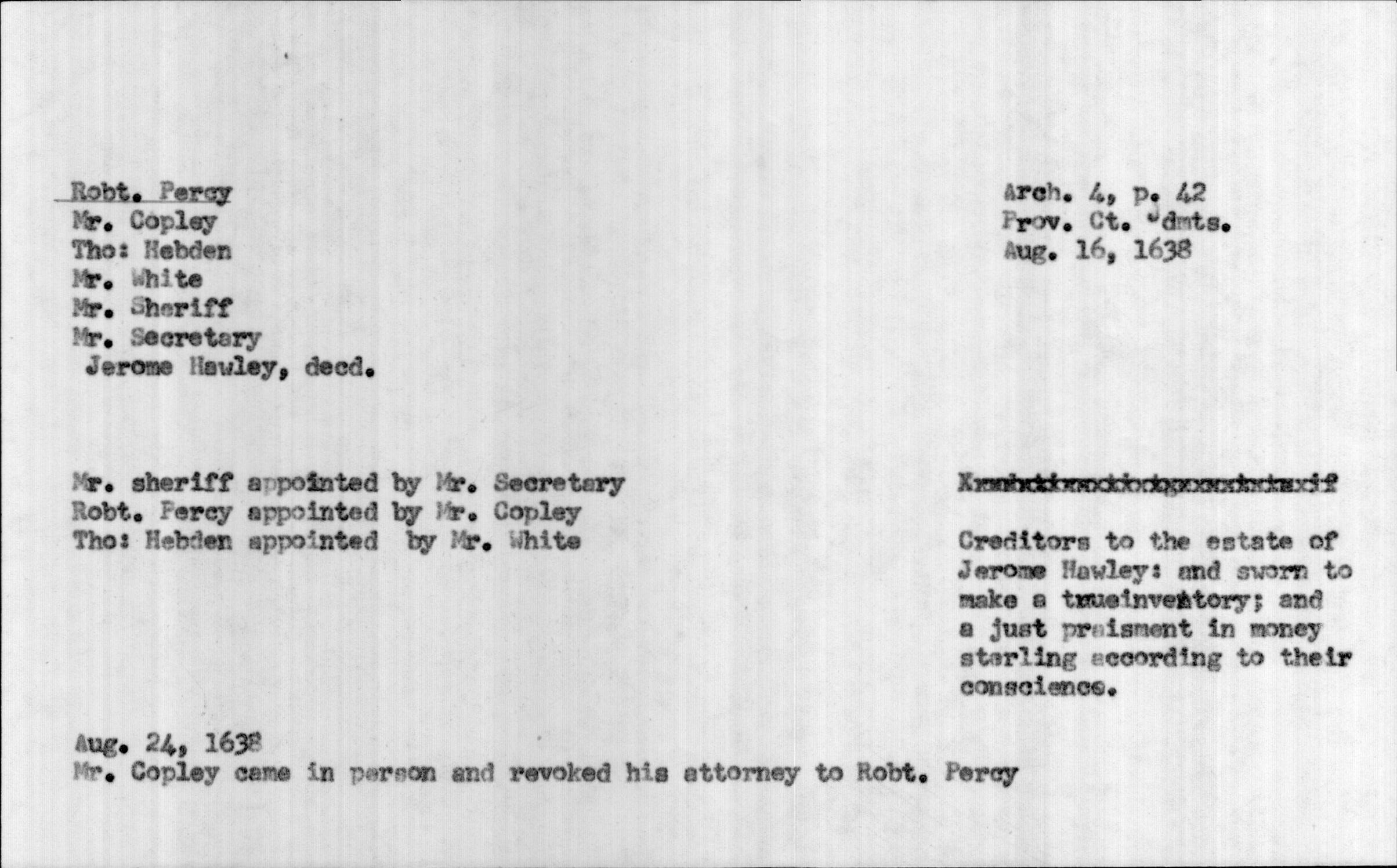 |
Item 4 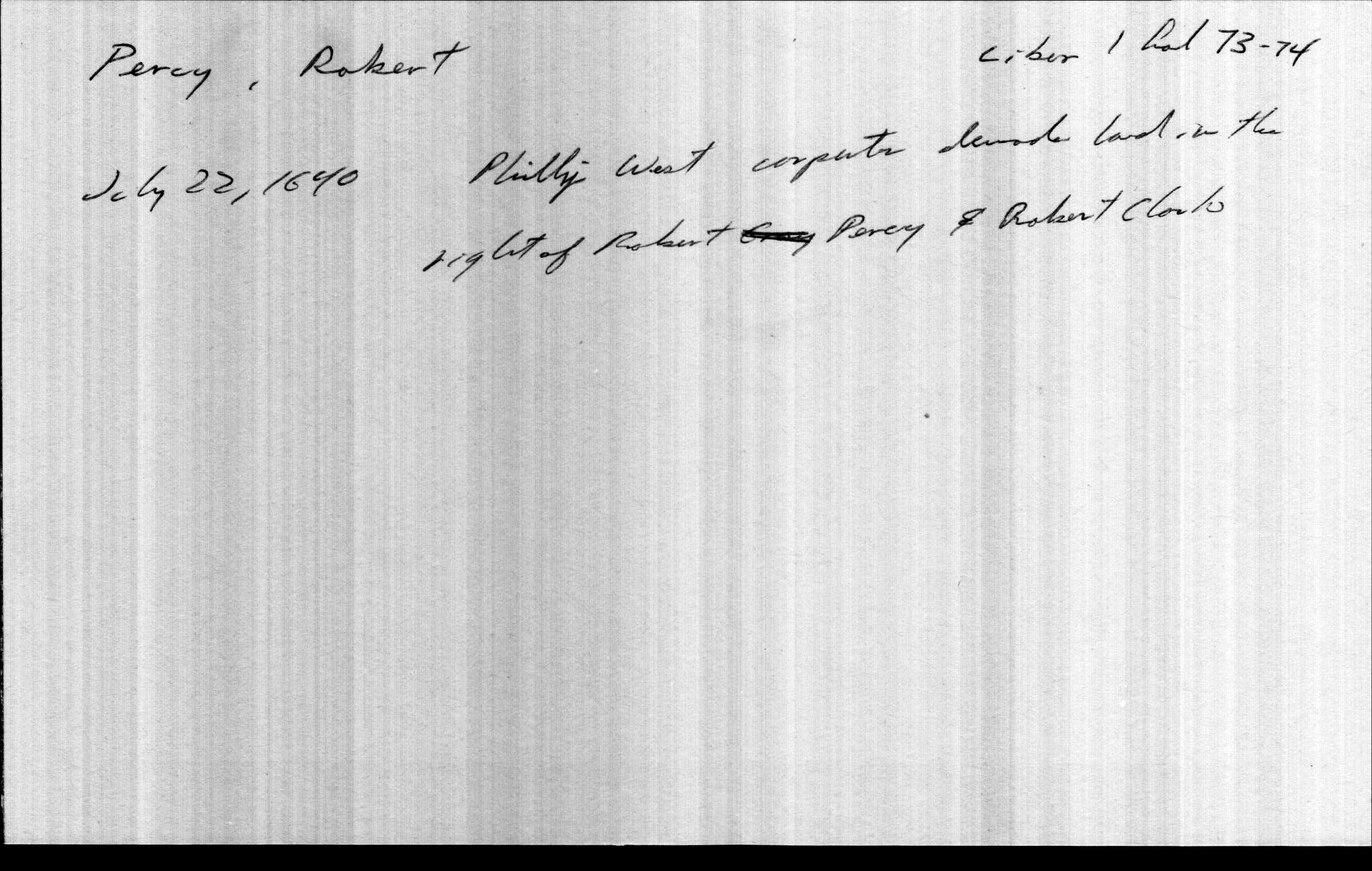 |
Item 5 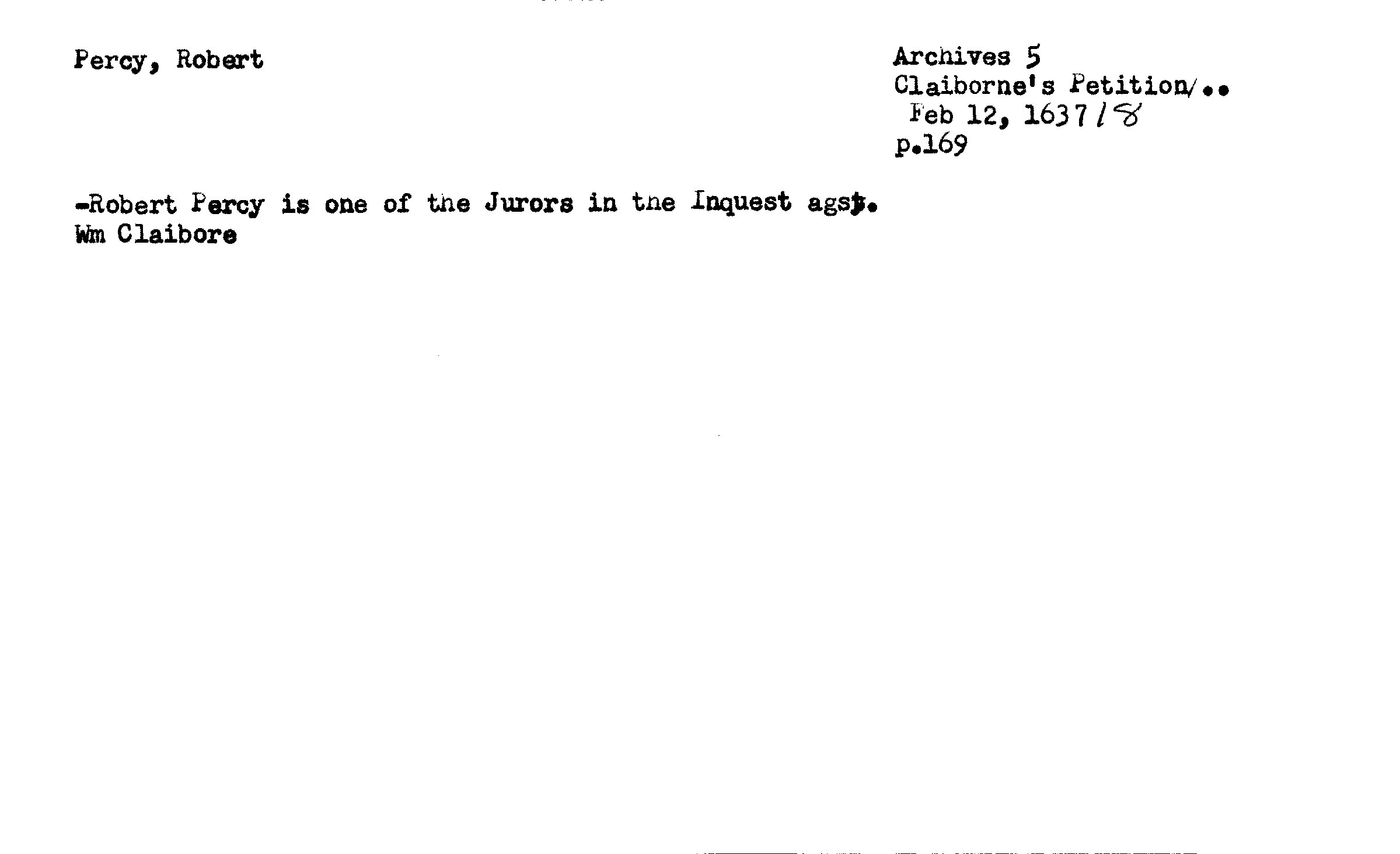 |
Item 6 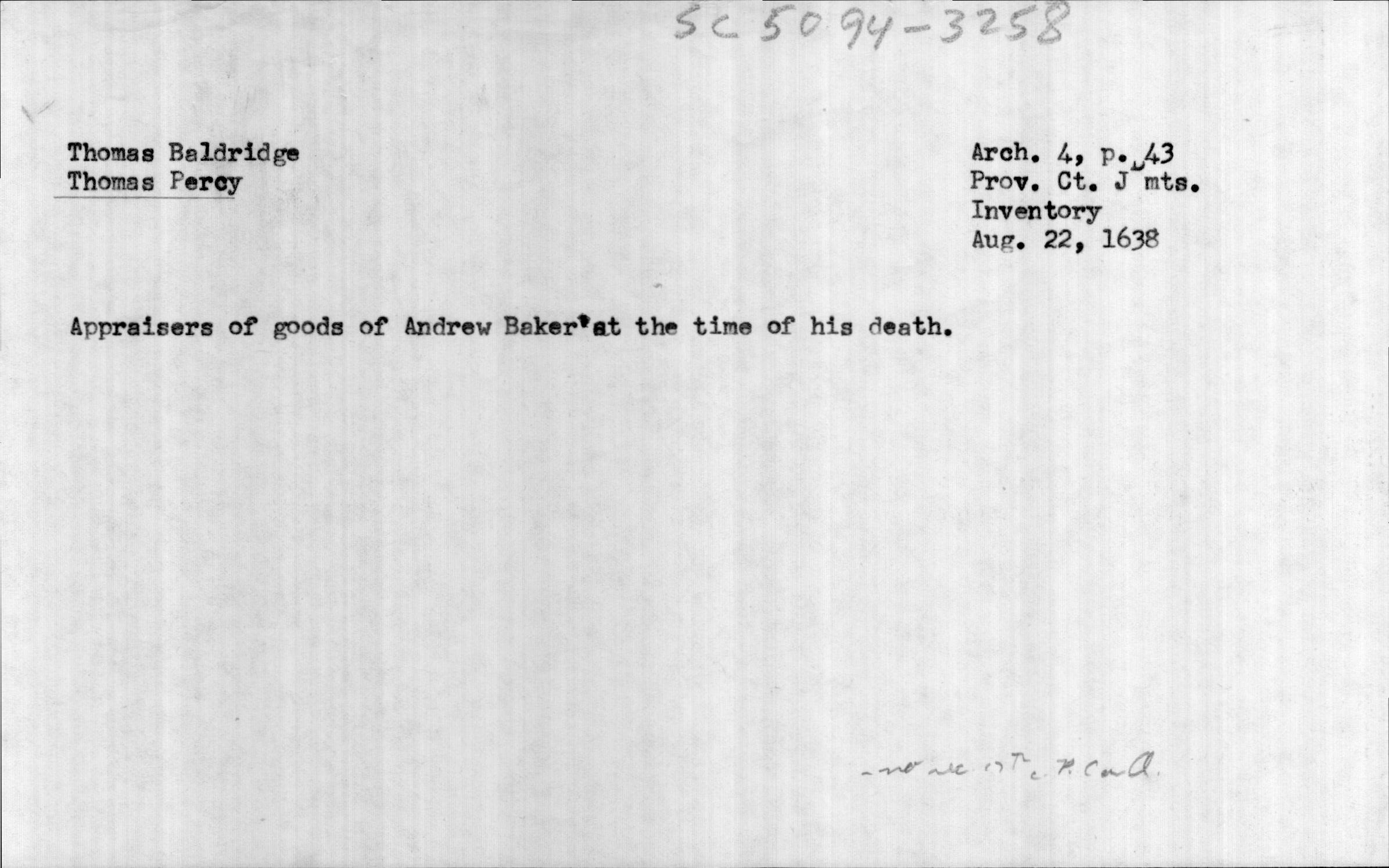 |
Item 7  |
Item 8 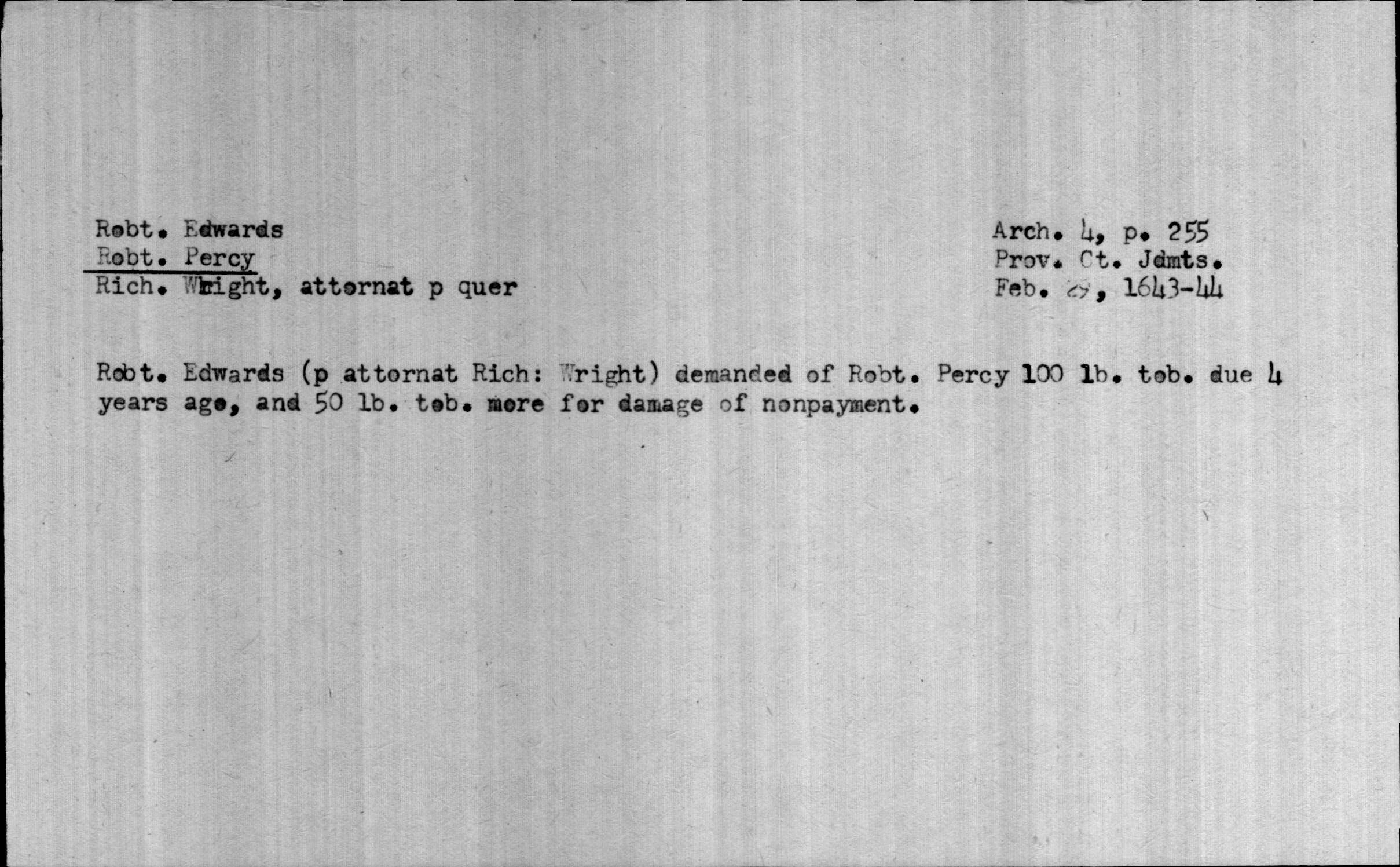 |
Item 9 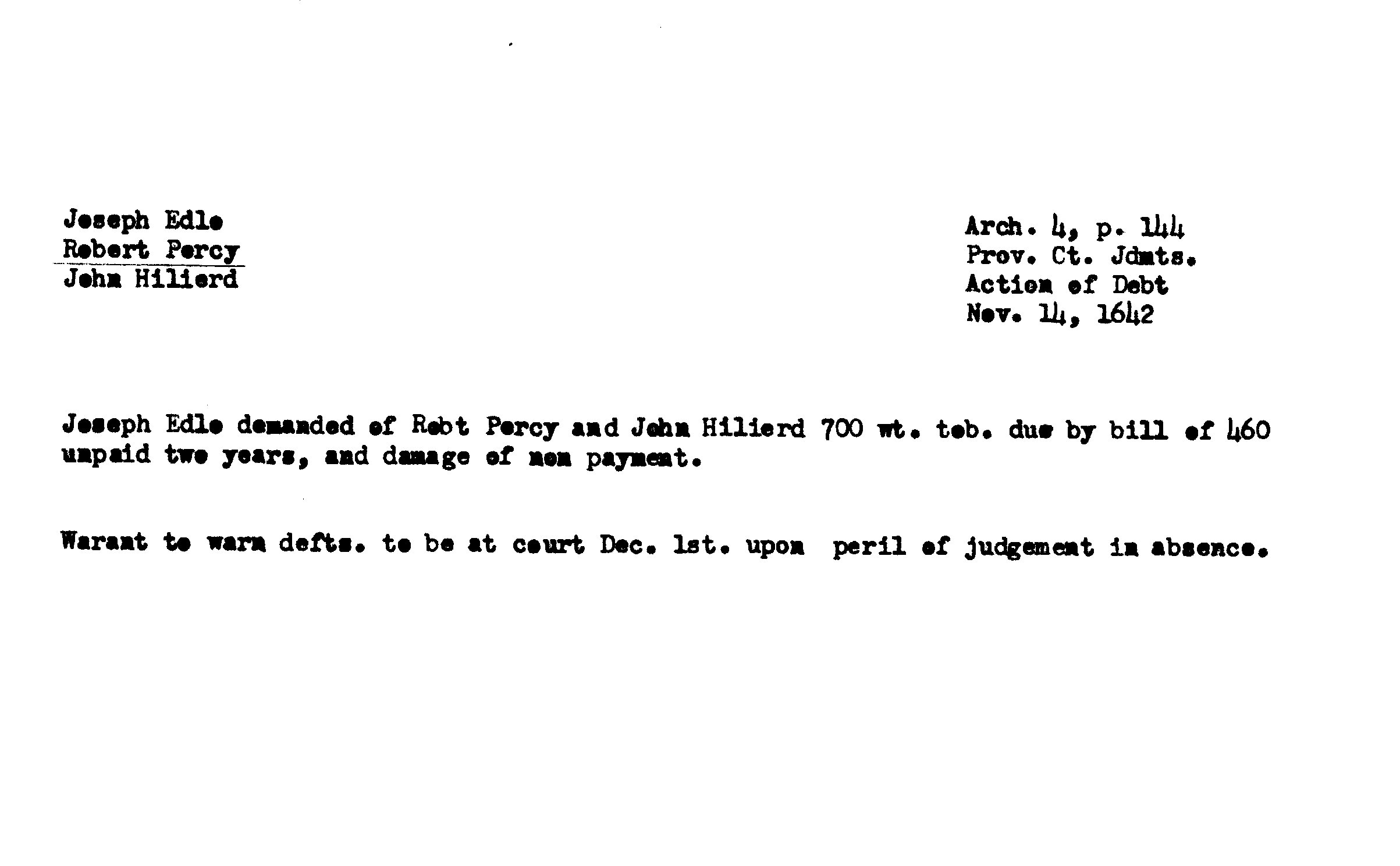 |
Item 10 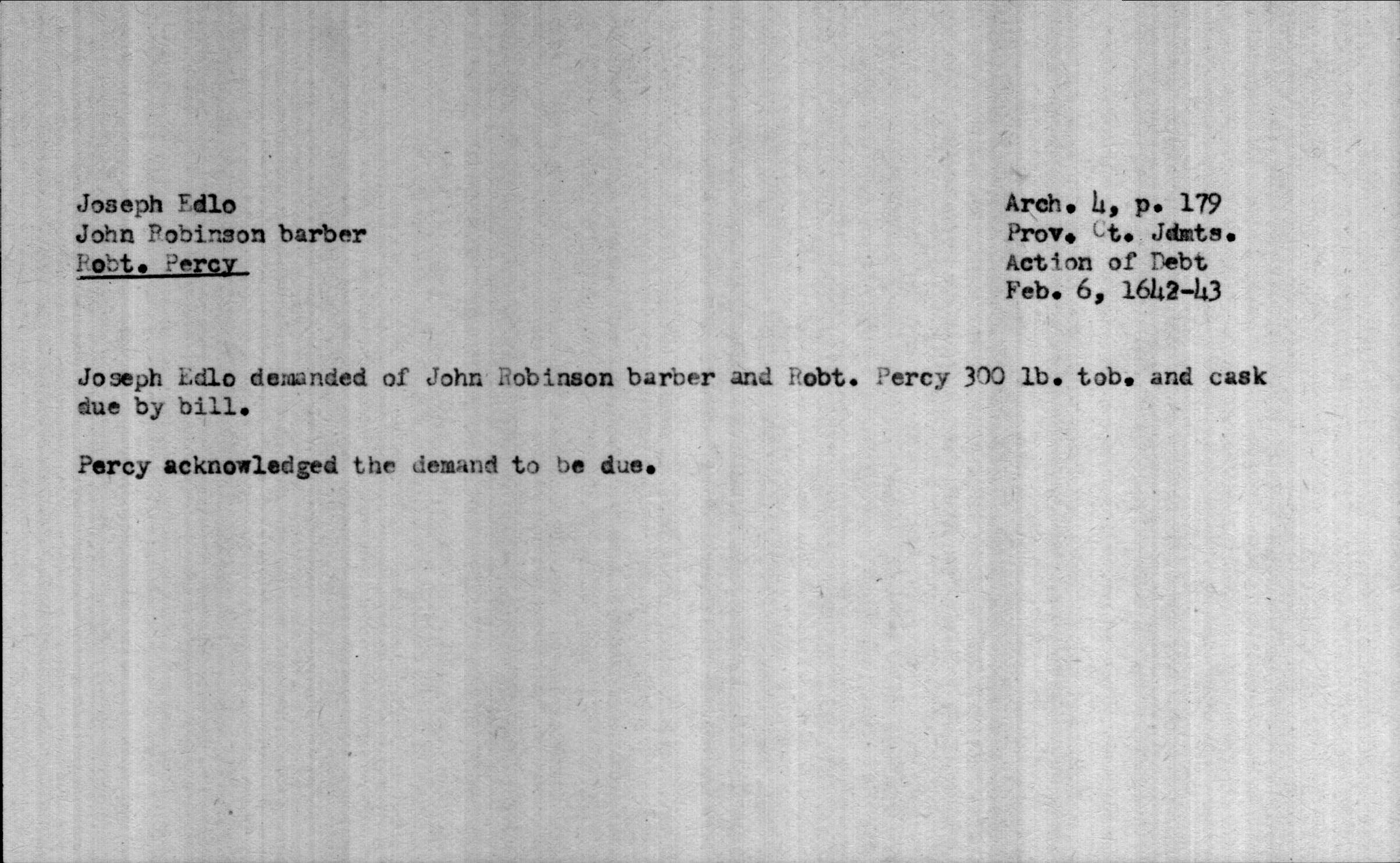 |
Item 11 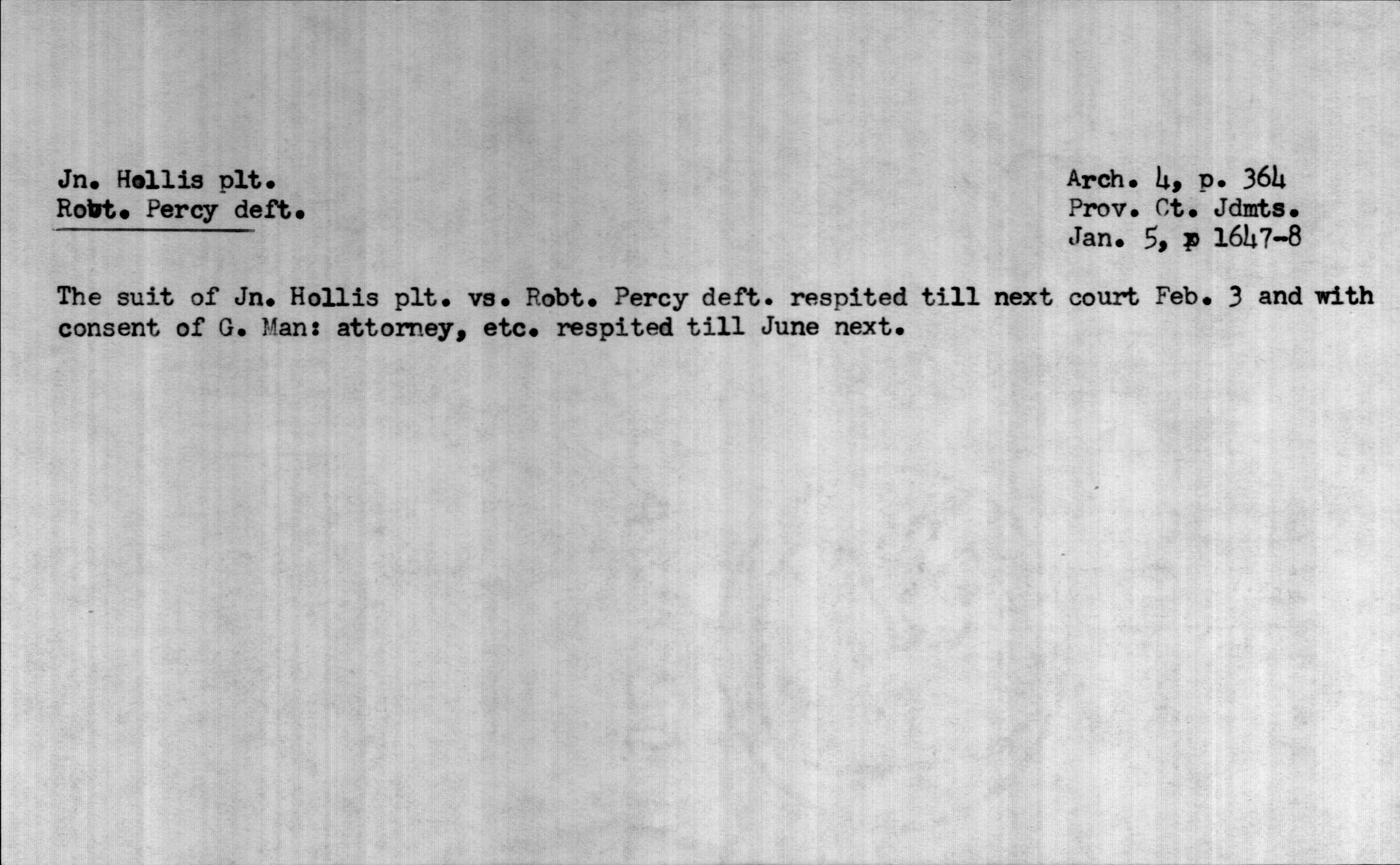 |
Item 12  |
Item 13 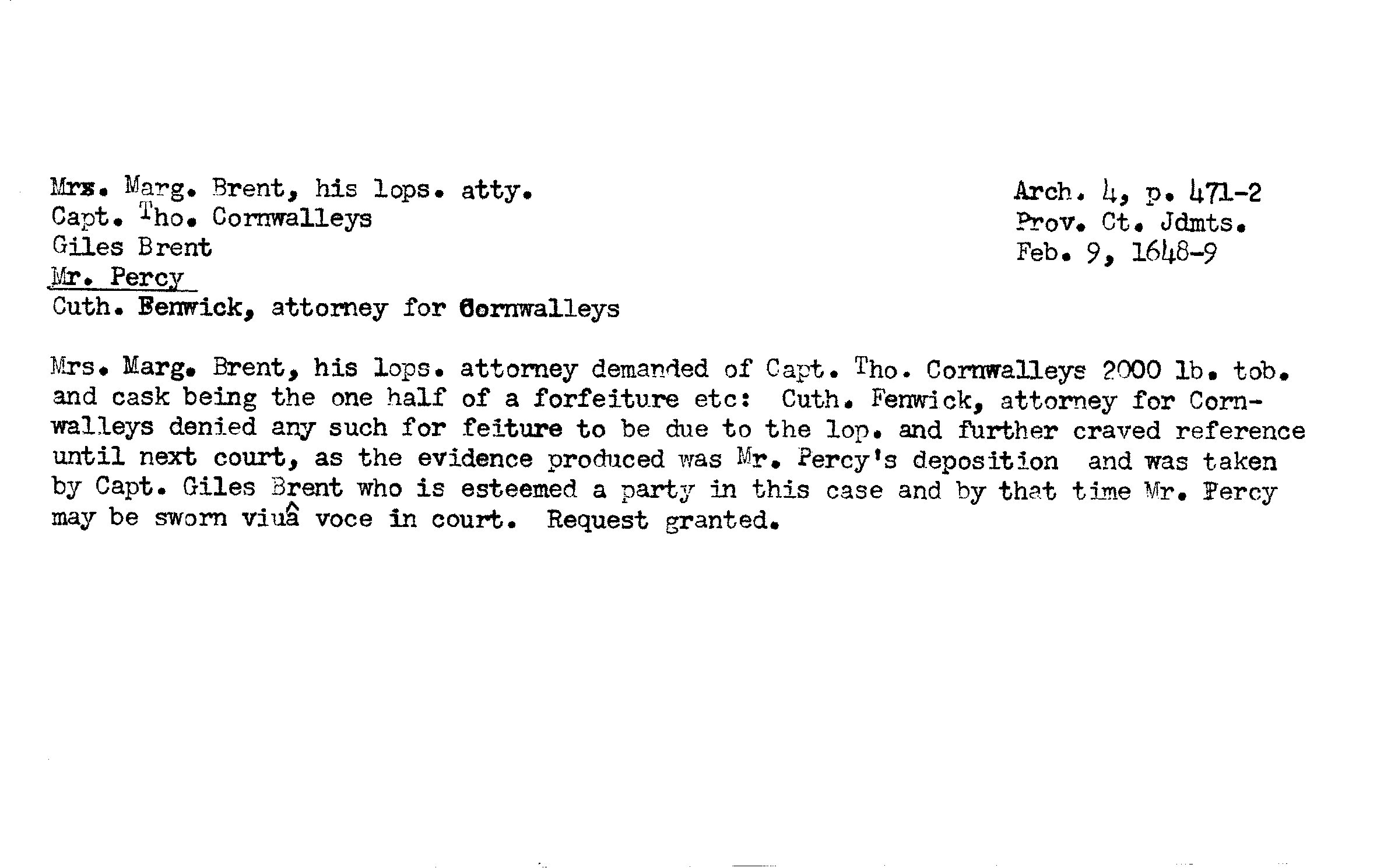 |
Item 14 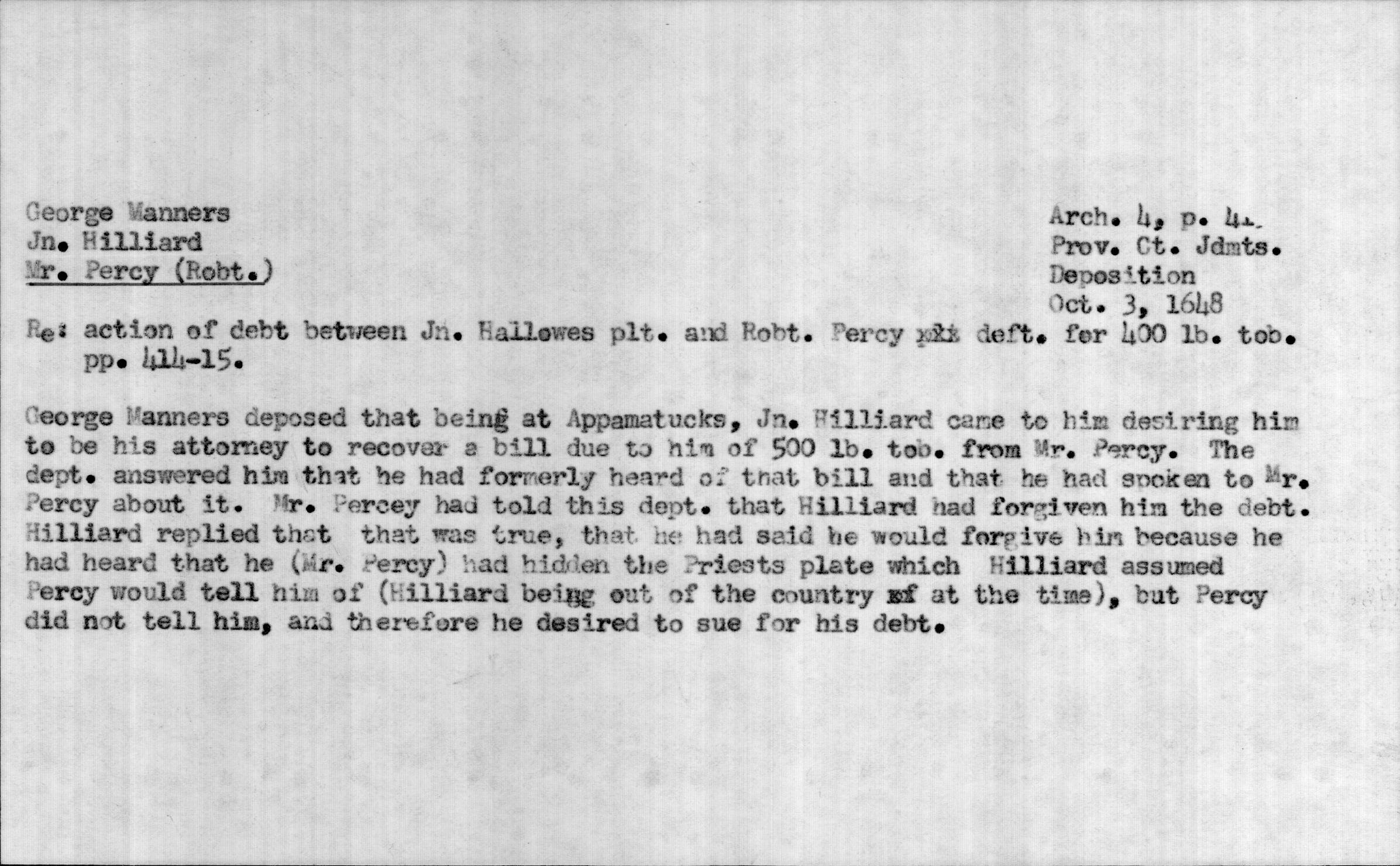 |
Item 15 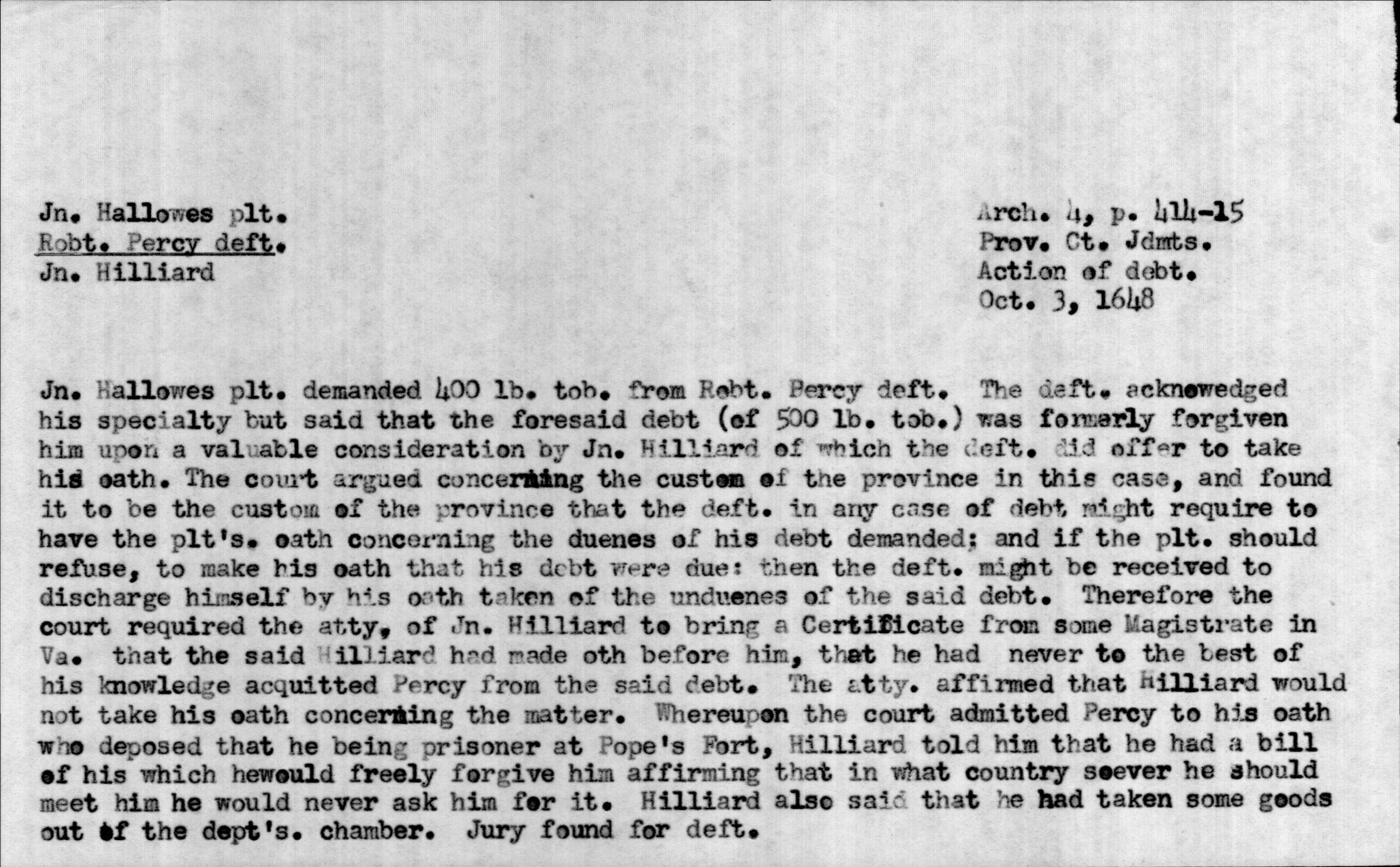 |
Item 16  |
Note what Item 14 above says:
"George Manners deposed that being at Appamatucks, John Hilliard came to him desiring him to be his attorney to recover a bill due to him of 500 lb. tob. from Mr. Percy. The deponent answered him that he had formerly heard of that bill and that he had spoken to Mr. Percy about it. mr. Percy had told this deponent that Hilliard had forgiven him the debt. Hilliard replied that that was true, that he had said he would forgive him because he had heard that he (Mr. Percy) had hidden the Priests plate which Hilliard assumed Percy would tell him of (Hilliard being out of the country at the time), but Percy did not tell him, and therefore he desired to sue for his debt."
More about this from Liberation Theology Along the Potomac: Labor's Golden Rule in Early American Catholicism Journal of Beliefs & Values: Studies in Religion & Education, Volume 32, Issue 3, 2011
Out of the regard for their own value came the militant support of Maryland's contract workers for the levelling of Calvert and the local Maryland landlords in the 1640s and 1650s, which will be taken up in the following chapter. Tenants and contract workers were only 20% of the population in this period, but led in the levelling. Catholic tenants like William Lewis, Henry Hooper, and Robert Percy stopped paying the three barrels of corn in annual rent on their 21-year leases.[347]
[347]"Thomas Gerard," "Career Files;" Hughes, Society of Jesus, text, vol. 2, p. 25. The Marshall was 'Robert Percy, gentleman;' there are strong grounds for believing that he was the eldest son of Thomas Percy, a chief conspirator of the Gunpowder Plot.
St. Mary’s County, MD. Court Records Assembly Proceedings, January— March 1637/8.
Liber Z, p. 15
THE GENERAL ASSEMBLY HELD AT ST MARIES, AND BEGAN ON THE 25th DAY OF JANUARY 1637
The Acts of the first dayThe Leiutent grail taking his place, came and appeared personally: Robert Perry marshall (Robert Percy served as undersheriff from 1638-1639).
January 20, 1637 St Mary’s County, MD. Cecellius Lord Proprietor to Rob Percy, “marshall” asked to apprehend the body of Rose Gilbert, widow and keep her safe.
February 12, 1637 – St. Mary’s County, MD. Robert Percy, one of 24 freemen selected to serve on grand inquest.
17th Aprill 1638 - Memorand that this day mr Sheriff hath appointed Robert Percy to be his bailiff or vndersheriff vntill xtmas next, to exequute for him all writt, & warrants vpon his command, for exequution of iustice or otherwise and hath promised him a salary therefore of 100l of tobacco: and the said Robert Percy hath accepted thereof, & doth covenant and vndertake to performe the same & to save harmelesse mr Sheriff for all neglects or defaults wch may be committed on the part of the said Robert Percy.
August 16, 1638 - Mr. Copley came in person and revoked his attorney to Robt. Percy, p.78 (Note information in the Jesuit Mission article below about Mr. Copley and Robert Percy as attorney.)
August 22, 1638 - A true and perfect inventary of all the goods and debts of Andrew Baker’s., their value praised by Thomas Baldridge and Thomas Percy.
From the Maryland Historical Magazine, p.366: Land Notes 1634-1655
March 28, 1640 Robert Percie, Gent., demandeth land to him for transporting himself at his own charge into the province upon the Merchant –Boneventure in the Year 1635 (Viz) 100 acres of land in ffreehold, and was allowed. Eod. The said Robert Percie assigned over his right and interest in the 100 acres of land unto John Dandie and his heirs
Robert Percy. (signed)July 21, 1640 The said Robert Percy Gent, demandeth ffive acres of Town Land due to him for transporting himself at his own charge into this province in the year 1635 – and assigned over all his right unto the Said five acres unto Robert Clerk, Gent.
February 1, 1643 Members of Inquest: robt. Percy
A LINK to the above mentioned documents and a few others:
Next:
THE JESUIT MISSIONS OF ST. MARY'S COUNTY, MARYLAND by EDWIN WARFIELD BEITZELL
In 1645, at the time of the Ingle Invasion, there were (as we have seen) five Jesuit priests in Maryland. Fathers Bernard Hartwell and John Cooper were at St. Inigoes, Father Roger Rigby on the Patuxent, Father Copley at St. Mary's City and Father White at Port Tobacco. For several years, Richard Ingle had been a trader in goods from England and Holland and was well known to the Manor Lords of St. Mary's.In the year 1644, Governor Leonard Calvert had occasion to visit his brother Lord Baltimore in England, and Giles Brent was substituted in his place during his absence. Ingle arrived in the harbor at St. Mary's in January in his ship, the "Reformation", and during his stay was accused of treason for speaking seditiously against the King. He was arrested and placed in the custody of the Sheriff, and the "Reformation" was seized, a proclamation affixed to the mast, and a guard placed aboard. Soon afterward, Ingle made his escape. The Sheriff excused himself, saying that there was no prison in the Province except his own hands, and he supposed everything was all right when he saw Ingle leave the Governor's house in the company of Captain Cornwaleys and Mr. James Neale and he let him go, though against his will. Mr. Neale said he had no charge over Ingle and did not help his escape. Captain Cornwaleys said he thought the Governor had given his consent for the prisoner's release. The Captain of the Guard excused himself, saying that he thought everything was all right when he saw Cornwaleys come aboard with Ingle, and all talking in a very friendly manner together. Thus the "Reformation" slipped out of the Sheriff's hands.
On his return to England, Ingle complained that his ship had been seized in Maryland because it was a London ship, and that Maryland was a stronghold of papists and supporters of the King against Parliament. Then Ingle procured letters of marque against all ships opposed to Parliament, and sailed for Maryland to avenge himself against the Government and the Catholics.
Ingle put in at St. Mary's on February 24, 1645, with the avowed purpose of burning or destroying whatever belonged to the Catholics, and to put the Protestants in possession of everything not destroyed. Ingle and his men captured the Fort at St. Inigoes and set out to rob and ravage the countryside. Fathers Hartwell, Rigby, and Cooper (as previously noted) were forced to flee for their lives across the Potomac to Virginia. Fathers Rigby and Cooper are reported to have died of hardship in Virginia in 1646. Father Hartwell died in the same year, although there is some indication that he may have returned to Maryland. Possibly, he did not flee to Virginia but went into hiding in Maryland. It is the writer's considered opinion that Fathers Rigby, Cooper, and possibly Hartwell were all martyrs, hunted down and killed by Ingle and his adherents. Otherwise it is difficult to understand how these three young priests could all have died in so short a period of time.
Father Copley was either visiting Father White or had fled to Port Tobacco from St. Inigoes. Both were captured by Ingle and were sent to England in chains, for trial on the charge of treason (the treason being that they were Jesuits). Actually, they were tried on the technical charge that they returned to England after being banished from that Country. The Fathers were able to prove that they had not returned voluntarily but had been brought back much against their will. They were finally acquitted, but were detained in custody for about two years.
Mission property valued at over 2,000 pounds sterling was seized or destroyed. In a schedule filed by Father Copley, together with an affidavit, when he sued Ingle for recovery some years later, he mentioned that a house was burned, some sixty cattle were dispersed, hogs and other animals had disappeared, and twenty indentured servants were missing. All of the church and house furnishings at St. Mary's City, St. Inigoes, and Port Tobacco were stolen. In the same document, mention is made of massive silver plate, jewelry of gold, diamonds, sapphire and ruby, and tapestries embroidered in gold and silver.(57) Very probably the plate, jewelry, and embroidered tapestry mentioned in the schedule were the sacred vessels and the vestments used in the Church service. Father Copley would hardly have dared to identify the stolen articles otherwise to a Court in England. Nor did he mention the destruction of the Chapel House, other than as "a house". Father Joseph Zwinge, S.J., has pointed out that it was the Chapel House that was destroyed, because the residence at St. Inigoes was in possession of a Mrs. Baldridge,(58) a Protestant, when Father Copley finally was able to return to Maryland in 1648, and the "Hill" house in St. Mary's City remained intact, as it was mentioned in a deed of 1667.(59)
Father Copley's former attorney, Robert Percy, seems to have known a great deal about the disappearance of the plate.(60)
** Robert Percy was a prisoner at Pope's Fort,6 and it was rumored that he had hidden the priest's plate. John Hilliard said he would forgive him a debt, hoping that Percy, who was about to leave the country, would tell him where it was hidden. But Percy did not tell him and so Hilliard sued in vain for the debt in Greene's administration. 6) Md. Arch., Prov. Ct., 415, 418, 419.
** The Protest of 1648, New Style.
We, the freemen assembled in this present general Assembly, do hereby declare, under our hands ; and generally, jointly, and unanimously protest, against the laws which are now pretended to be put in force by the last general Assembly ; conceiving that they were not lawfully enacted. For that no summons issued out return, we may suppose, of all the Roman Catholics, who had been expelled or exported from St. Mary's, by Capt. Ingle, and the other enemies of the proprietary.
Witness our hands, this 28th January, 1647.
Robert Yaughan, 24 voices.
Robt. Clarke, proxy,
Geo. Akerick, 8,
Cuthbert Fenwick, 8,
Walter Peake, 22,
Robert Percy, proxy, 1December 2, 1649 Robert Percy defendant for 400 Tobo. Robert Percy a prisoner at Pope’s Fort over this debt.
Robert Percy is not found in any record after December 2, 1649, evidently being ejected or fleeing from Maryland. See above where it says he was “about to leave the country” in 1648.
Now, we know that Richard Peirce/Pierce/Pearce showed up in Waltham Abbey to marry Susannah Wright in 1642. Five years later, they are in America where Susannah receives a legacy in 1647 in Rhode Island. A year later, Robert Percy, who is in trouble in Maryland, is enabled to depart. In any event, the Robert Percy went to America in 1635 and made something of a Catholic splash there was in jail in 1648 but disappears shortly after that.
Then a Robert Pierce, innkeeper, dies in Waltham Abbey with no prior connections recorded there other than the fact that he has the same name as our Richard Pierce/Pearce. A singular lack of Pierces… And oddly, a month later, a Charles Morgan dies at “Richard Pierces”. But we KNOW Richard Pierce who married Susannah in Waltham Abbey is in America! Did he maintain a home in Waltham Abbey? Did he and Susannah get Robert Pierce out of jail and help him get back to England to live in his home there? Did Robert Percy/Pierce/Pearce have some of the Jesuit plate and use it to open an inn?
1661 Robert Pierce, innkeeper, 22 October.
1661 Charles Morgan died at Richard Pierces and was buried 19 November.
We have the following points:
It happens that Thomas Percy married Martha Wright and two members of the Gunpowder plot were Wrights of Yorkshire.
Was there a son, a Robert Percy, Gentleman born about 1594 England, taken to London or environs, by his mother? Notice that Dugdale wrote: "It is unknown where he died." That is to say, his son had no idea what happened to his father!!!
That may be because he hopped on a ship and went to America WITHOUT HIS FAMILY!
Then, all those doings in America until he disappears in 1649 never to be heard from again. And then, after a Richard Pearce marries a Wright in Waltham Abbey, suddenly a Robert Pierce shows up???
Was there another son of Thomas Percy and Martha Wright?
It just seems to me to be bizarrely coincidental that one year after Richard and Susannah show up in America, Robert Percy is "planning to leave". And all this was in the midst of a really horrible religious persecution going on in Maryland triggered by the English Civil War.
Did Robert Percy encounter his son, Richard, in America and was he helped by him to return to England at the age of 55 after changing his name as Richard had already done? Did he contact some of his old circle which may have included such as the Dells, the Brights, and certainly the Wrights? With their help, did he settle in Waltham Abbey, and open an Inn?
Richard is not mentioned in the affidavits for Francis, but he is certainly there on the Charts in "The House of Percy" and the way it is written and presented reads like a cover-up to me.
What interested me was the testimony of the Countess of Pembroke in "The House of Percy" followed by a few comments about the "Four Lost Percies" in relation to the Tempest family. As it happens, Elizabeth Waterton's mother was a Tempest though the book does not mention that.
So we have this clear problem of Four disappearing Percies, and a huge gap between the age of fecundity of Edward Percy and Elizabeth Waterton and the birth of Alan Percy (1560). They had plenty of time to have four other children, including the Henry b. 1555 and a Robert b. 1556 and a couple others. But they would have to be small to be smuggled out in "hampers".
So there's that.
Then, there is the issue of the Thomas Percy children. It is apparently known that Martha Wright Percy re-settled north of London, probably near to her kin, along with her children, and that she changed her name. Well, if she changed her name, she undoubtedly changed the names of her children, too. This is why I have doubts about the Francis Percy even though his widow claimed that his father was Thomas Percy. But the testimonies of the Alnwick people that there were children is helpful.
Would the children of Thomas Percy/Martha Wright have associated with the offspring of the Four Percies? Possibly, even probably, because they were all connected by this network of closet Catholics. Possibly many of them would not even be listed in Anglican church registries after a certain point because they were catholic.
I think that TWO things happened and were conflated: 1) the removal of several Percy children during the "troubles" of 1559, and then 2) the "removal" of the children of Thomas Percy of Gunpowder plot. But the latter was a full generation later. I think that the "Four Percies" were undoubtedly children of Edward of Beverley and Elizabeth Waterton whose mother was a Tempest. There seems to be something solid there. There was Henry, Robert, Laurence and Anne. That’s the line of the Trunkmaker and other Percys who did not change their name to Pierce/Peirce/Pearce.
In my opinion, the Robert of the Four Percies is NOT the same Robert that married Emma Meade in Wivelscombe in 1615 because he is the wrong age. I'm not entirely sure that the Francis Percy m. Richoard, born in Bickley, belongs there, but I've left him there tentatively due to the testimony of the widow.
But it is entirely possible that a Robert Percy, son of Thomas (GPP) resumed his father’s name upon reaching adulthood because he was a zealous Catholic, married, and later, went to America to try his hand at farming and catholicizing, and failed, ended up in jail. After that, he may have been helped by either his son or a nephew, Richard Pierce/Pearce and wife Susannah, and persuaded finally to change his name permanently and retire to run an inn.
*********************
It's going to take a real Sherlock Holmes to sort it out and find anything IF there is anything to find.
Below I have included the descendant chart for my proposed ancestry of Richard Pearce who married Susannah Wright at Waltham Abbey, following which, they emigrated to Rhode Island. You can download it for easier reading.
